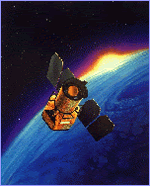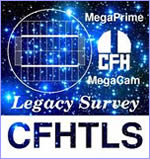 |
| AEGIS Teams | |
| (listed from high energy to low energy) | |
 |
Chandra The Chandra survey of the Extended Groth Strip (EGS) is an X-ray imaging and low-resolution spectroscopy survey using the Chandra X-ray Observatory, one of NASA's Great Observatories. Observing in the high energy X-ray regime of the electromagnetic spectrum allows the detection of active galactic nuclei (AGN) and hot gas. The survey consists of 1.6 megaseconds of Chandra observing time and covers the whole of the EGS field. Active team members include Kirpal Nandra (principal investigator), Antonis Georgakakis, Elise S. Laird and James Aird. Additional information on the Chandra survey of the Extended Groth Strip can be found at the Chandra AEGIS website. |
 |
GALEX The Galaxy Evolution Explorer (GALEX) is a space telescope in orbit around the Earth. It is sensitive to the ultraviolet region of the electromagnetic spectrum. For AEGIS, the ultraviolet is important in determining the rate at which stars form in a galaxy's recent history, or about 100 million years before observation. A galaxy's most massive stars are bright in the ultraviolet, but also short-lived. Therefore, only galaxies that are currently forming stars will be bright in ultraviolet light. Active team members include C. Martin (principal investigator), S. Salim, D. Schiminovich, Todd Small, and M. Rich. For more information about GALEX please visit the GALEX website. |
 |
Hubble / ACS The Advanced Camera for Surveys (ACS) is Hubble's main imaging camera. It consists of three electronic cameras and a complement of filters that take pictures in ultraviolet, visible, and near-infrared wavelengths from 1200-10,000 angstroms. The Hubble/ACS mosaic image in AEGIS is the second-largest Hubble mosaic in existence and is the largest in two colors. It covers about half of the central Extended Groth Strip field. Tens of thousands of galaxies are visible, whose sizes, colors, and morphologies stand out clearly with Hubble's super-sharp detail. The Hubble/ACS team in AEGIS was assembled especially to create the AEGIS mosaic. Active members are: Marc Davis (principal investigator), Matt Ashby, Kevin Bundy, Michael Cooper, Sandra Faber, Puragra Guhathakurta, David Koo, Shui Kwok, Anton Koekemoer, Jennifer Lotz, Jeff Mader, Anne Metevier, Jeff Newman, Kai Noeske, Luc Simard, Tod Small, Ben Weiner, Christopher Willmer. |
 |
CFH12K Imaging The initial optical imaging for AEGIS was provided by data from the CFH12K camera on the 3.6-meter Canada-France-Hawaii Telescope (CFHT). The CFH12K camera has a 12,288 x 8,192 pixel CCD mosaic array and a field of view of 0.70 x 0.47 degrees. Four pointings were imaged along the EGS in 3 bands - B, R, and I - with integration times of an hour each in B and R and two hours in I. These data were used to select spectroscopic targets for the DEEP2 Redshift Survey and determine their rest-frame optical colors and magnitudes, which tells us how luminous and massive the galaxies are and whether they are actively forming stars. Active members are: Nick Kaiser (principal investigator), Alison Coil, and Jeff Newman. |
 |
CFHT Legacy Survey The CFHT Legacy Survey (CFHTLS) is a large-scale imaging survey being conducted with Megacam at the Canada-France-Hawaii Telescope(CFHT) under the auspices of Canada and France. One of the four CFHTLS Deep fields is centered on the Extended Groth Strip. Taken in five wave-bands from the ultraviolet to near infrared, the CFHTLS exposures last from 30 to 130 hours and represent the deepest that one can go over large fields of view using ground-based telescopes. The multi-wavelength images yield crude "spectra" of tens of thousands of galaxies, which can be analyzed to estimate rough distances ("photometric redshifts") for objects that are otherwise too faint for normal spectra. CFHTLS is an independent survey and is not formally a participating AEGIS team. However, AEGIS is making use of CFHTLS data. CFHTLS members who are also AEGIS members are Stephen Gwyn, Mike Hudson, and Luc Simard. |
 |
DEEP2 Redshift Survey The Deep Extragalactic Evolutionary Probe (DEEP) survey is a two-phased project using the Keck telescopes to study the distant Universe. Phase 1 studied a sample of roughly 1000 distant galaxies, including hundreds of objects in the Extended Groth Strip, as a pilot program for DEEP2. Phase 2 of DEEP has used the new DEIMOS spectrograph to obtain spectra of 50,000 faint galaxies with redshifts up to 1.4 (up to 9 billion light years away), including roughly 14,000 in the Extended Groth Strip. The main scientific goals of DEEP2 are to study the evolution of both the properties of galaxies and their clustering over two-thirds of the history of the Universe. It complements recent studies of the local Universe such as the Sloan Digital Sky Survey and the Two Degree Field Galaxy Redshift Survey by studying much fainter and more distant galaxies. In addition to measuring the redshifts of the target objects, which allows us to determine their distances and map their positions in three dimensions, the data obtained allow us to measure the rates at which these galaxies are forming stars, their masses, and many other quantities. Active members are: Marc Davis (principal investigator), Sandra Faber, David Koo, Puragra Guhathakurta, Alison Coil, Andrew Connolly, Charles Conroy, Michael Cooper, Darren Croton, Brian Gerke, Genevieve Graves, Justin Harker, Jennifer Holt, Anthony Hopkins, Susan Kassin, Nicholas Konidaris, Lihwai Lin, Jennifer Lotz, Anne Metevier, Joe Miller, Jeff Newman, Kai Noeske, Andrew Phillips, Ricardo Schiavon, Ben Weiner, Christopher Willmer, Greg Wirth, Renbin Yan. |
 |
CfAO Treasury Survey The Center for Adaptive Optics Treasury Survey (CATS) is a long term survey aimed for high resolution studies of galaxy evolution. This is achieved by correcting atmospheric distortions with an adaptive optics system in the near-IR. With 8-10 meter class telescopes such as Keck or Gemini, the near-IR spatial resolution from adaptive optics, roughly 0.05 arcsec, matches very well to that achieved in the optical by HST and thus allows new and more powerful measures of galaxy properties. The near-IR from 1.2um to 2.2um is useful to add to the optical HST data. For distant galaxy studies, the near-IR corresponds to the optical light that originally left the source billions of years ago. Near-IR observations improve estimates of the galaxy's mass in stars, and are less subject to extinction by dust. The participating CATS team members in AEGIS include David Koo, Anne Metevier, and Jason Melbourne. Their AO work is being done on the Keck II Telescope. |
 |
Palomar Near-Infrared The Palomar survey of the EGS and other DEEP2 fields supplements the optical and spectroscopic data for investigation the stellar masses and near infrared properties of distant galaxies. Near infrared (NIR) observations of the EGS in the J and K bands were obtained using the Wide-field Infrared Camera (WIRC) on the Palomar 5m telescope. The observations were carried out between 2002 and 2005. WIRC has an effective field of view of 8.1'x8.1', with a scale of 0.25"/pixel. The EGS observations consist of 33 WIRC overlapping pointings, each with 4x30s exposures dithered over a non-repeating 7" pattern, for a total coverage of 2400 arcmin^2 in the EGS. Typical total exposure times at any given location within the EGS are 1-2 hr. The net setting FWHM ranges from 0.8" to 1.2". Photometric calibration was carried out by referencing standard stars during photometric conditions. The final images were made by combining individual mosaics obtained over several nights. The images were processed using a double-pass reduction pipeline developed specifically for WIRC. Active team members are Kevin Bundy, Christopher Conselice, Peter Eisenhardt, and Richard Ellis. |
 |
Spitzer / IRAC the Infrared Array Camera(IRAC) is one of three instruments on the Spitzer Space Telescope. The IRAC camera is a highly sensitive camera that takes images at wavelengths in the infrared part of the spectrum. Infrared light is like visible light but of longer wavelength, invisible to human eyes. IRAC is important for measuring the total amount of stellar mass in galaxies. The participating IRAC team in AEGIS is the IRAC GTO, which is the group responsible for building and testing IRAC on Spitzer. Active team members are: Giovanni Fazio (principal investigator), Matthew Ashby, Pauline Barmby, Peter Eisenhardt, Jiasheng Huang, Leonidas Moustakas, Mike Pahre, Steve Willner, and Gillian Wilson. |
 |
Spitzer / MIPS The Multiband Imaging Photometer (MIPS) is one of the three science instruments aboard the Spitzer Space Telescope. MIPS has 3 detectors that provide very deep imaging at mid to far infrared wavelengths of 24, 70, and 160 microns and is 100 times more powerful than previous instruments in this wavelength ranges. Deep maps with MIPS will be particularly valuable in the AEGIS program by enabling detection of distant galaxies that are luminous in the infrared due to very dusty strong starbursts and dust obscured radiation from active supermassive black holes (active galactic nuclei). AEGIS is one of the "deep surveys" being conducted by the instrument team. The Spitzer Legacy Survey (below) will significantly improve the depth of MIPS data in AEGIS. The participating MIPS team in AEGIS is the MIPS GTO, which is the group responsible for building and testing MIPS. Active team members are: George Rieke (principal investigator), Casey Papovich, Emeric Le Floch, Eiichi Egami, Christopher Willmer, Delphine Marcillac, and Samir Salim. |
 |
Spitzer / FIDEL The Multiband Imaging Photometer for Spitzer (MIPS) is an instrument on the Spitzer Space Telescope that images the sky at far-infrared wavelengths from 24 to 160 microns. The Far-Infrared Deep Extragalactic Legacy Survey (FIDEL) will use MIPS to detect fainter objects over wider areas of the sky than any previous survey, and will be the first survey to study thermal emission from warm dust from thousands of galaxies at cosmological distances. Star formation and active nuclei in galaxies can emit copious amounts of energy as galaxies and their central black holes grow and evolve. Much of this activity is hidden from optical view in dusty environments. The energy is absorbed by the dust, and then reradiated at far-infrared wavelengths, where it can be detected with MIPS. The Extended Groth Strip is one of three fields to be studied in this Spitzer MIPS Legacy Survey, along with the Extended Chandra Deep Field South, in the southern sky, and the Great Observatories Origins Deep Survey North field. Active team members include Mark Dickinson (principal investigator), David Frayer, Ranga-Ram Chary, Minh Huynh, Emanuele Daddi, David Elbaz, David Alexander, Casey Papovich, George Rieke, and many collaborating members of the teams responsible for the AEGIS, ECDFS/GEMS, GOODS, and the SCUBA2 Cosmological Legacy surveys. |
 |
VLA 6cm / AEGIS06 The Very Large Array (VLA) radio telescope is a large radio telescope consisting of 27 radio antennae whose signals are combined interferometrically. Its radio images are the sharpest and deepest in the world. The AEGIS06 survey was a precursor to AEGIS20 using much less observing time. Because of the shorter observing wavelength, 6 cm instead of 20 cm, 74 pointings were needed to cover the Extended Groth Strip. Because of the lower sensitivity, fewer sources were found, but almost all of them are powered by accreting black holes at the centers of galaxies, not by more common processes related to star formation. Unlike typical radio surveys, where only about 75% of radio sources can be studied at other wavelengths, this suvey has an identification rate larger than 92%. This is because the survey area is observed so well at so many other wavelengths. Many of the radio galaxies can be identified only because of the infrared observations. The AEGIS06 team members are Steve Willner (principal investigator), Alison Coil, Miller Goss, Matt Ashby, Pauline Barmby, Jiasheng Huang, Rob Ivison, David Koo, Eiichi Egami, and Satoshi Miyazaki. |
 |
VLA 20cm / AEGIS20 The Very Large Array (VLA) radio telescope is a large radio telescope consisting of 27 radio antennae whose signals are combined interferometrically. Its radio images are the sharpest and deepest in the world. The AEGIS20 survey consists of six very deep pointings along the Extended Groth Strip using the VLA at 20 cm wavelength. Radio images are important for identifying galaxies with active (accreting) black holes in their nuclei and also for measuring the total star formation rate, including star formation shrouded by dust clouds that other instruments cannot see. The AEGIS20 team was assembled specifically to map the Extended Groth Strip at radio wavelengths. Active team members are Sandra Faber (principal investigator), Scott Chapman, Rob Ivison, Marc Davis, Ian Smail, Steve Willner, and Gillian Wilson. An even more extensive survey, with twice the depth and resolution, is planned (co-principal investigators: Mark Dickinson, Rob Ivison). |